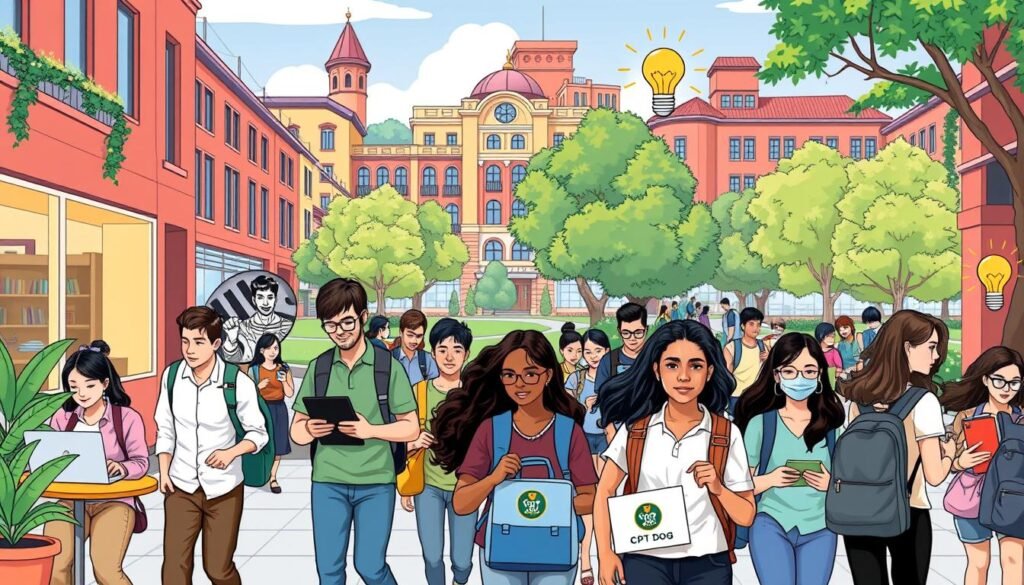If you’re an international student in the United States, you might have heard about Day 1 Curricular Practical Training (Day 1 CPT). It’s a chance to work off-campus right when your classes start. But is it really as great as it sounds? Let’s look into the myths and facts about Day 1 CPT.
Key Takeaways
- Day 1 CPT lets international students work off-campus from the start of their studies.
- More U.S. schools are offering Day 1 CPT programs. They mix learning with real-world experience.
- Getting into top universities doesn’t automatically mean you’ll get an F1 visa. USCIS looks at the school’s accreditation and the program’s relevance.
- It’s important to show you have strong ties to your home country to get an F1 visa.
- To keep your F-1 status, you need to stay in good standing and give honest answers during visa interviews.
But are the stories about Day 1 CPT just rumors? Are there risks or legal issues you should know about? Could Day 1 CPT really be the way to get a well-rounded education and better job chances in the future? Let’s find out the truth about this interesting opportunity.
Understanding Day 1 CPT
If you’re an international student in the U.S., you might know about Curricular Practical Training (CPT). It lets you get hands-on experience in your field of study. Day 1 CPT is special because it lets you work off-campus right when you start your studies.
What is Day 1 CPT?
Day 1 CPT is a program that lets international students work right away when they start school. So, you can start your practical training as soon as your program starts. You don’t have to wait for a certain time.
Eligibility Criteria for Day 1 CPT
- Enrollment in a full-time course of study
- The practical training must be an integral part of your curriculum and directly related to your field of study
- Approval from your school’s Designated School Official (DSO)
Differences Between CPT and OPT
CPT and Optional Practical Training (OPT) both offer work authorization for international students. But, they have some key differences:
- Timing: CPT can be used during your academic program, while OPT is typically completed after graduation.
- Duration: CPT is limited to 20 hours per week during the academic year, while OPT can be full-time.
- Eligibility: CPT is specific to your degree program, while OPT is more flexible and can be used in a wider range of fields.
It’s crucial to weigh the pros and cons of both CPT and OPT. This will help you choose the best option for your career goals and situation.
Myths Surrounding Day 1 CPT
Day 1 Curricular Practical Training (CPT) has many myths. It’s important to know the truth about Day 1 CPT. This knowledge helps students make good choices and succeed in their studies.
Common Misconceptions
Some think Day 1 CPT can ruin their F1 visa chances. But this is not true. The idea of “CPT schools” is also wrong. Day 1 CPT follows the F1 visa rules.
Legal Status and Compliance
Day 1 CPT’s legal status is unclear. The USCIS doesn’t give clear rules for these programs. So, students need to be careful when choosing Day 1 CPT.
Impact on Future Employment
Day 1 CPT might affect future visa chances. Immigration checks past visa statuses. This shows why it’s key to know the risks of Day 1 CPT.

International students should really understand Day 1 CPT before joining. Talking to a DSO and immigration experts is wise. They can guide students to make choices that fit their career plans.
The Benefits of Day 1 CPT
Day 1 Curriculum Practical Training (CPT) opens doors for international students in the U.S. It combines learning with real-world job tasks. This way, students learn to manage time and handle multiple tasks.
Gaining Practical Experience
Day 1 CPT lets you get hands-on experience in your field. You can use what you learn in class to solve real problems. This makes your resume stronger and helps you stand out in job searches.
Networking Opportunities
This program is also great for making professional contacts. You’ll work with experts and future colleagues. These connections can lead to job opportunities or help you find your next job.
Financial Benefits
Day 1 CPT also helps with money matters. Many schools offer it at a lower cost. You might find paid internships or part-time jobs too. This can help pay for your studies while you gain work experience.
Choosing Day 1 CPT can open many doors for international students. You’ll get practical experience, build your network, and find financial support. It’s a smart move that can boost your education and career.
Real-World Applications of Day 1 CPT
Day 1 Curricular Practical Training (CPT) gives international students a chance to start working in their field right away. This approach to internships and work is used in many industries. It shows how Day 1 CPT is used in real-world settings.
Industries That Frequently Use Day 1 CPT
Day 1 CPT is great for industries that need hands-on experience. Some of these include:
- Healthcare: It’s perfect for students studying healthcare because it teaches them about medical documents and how to get paid.
- Technology: The tech world moves fast, and Day 1 CPT lets students start working quickly.
- Finance and Accounting: These fields need students to know about rules and best practices early on, which Day 1 CPT helps with.
Case Studies of Successful Applicants
Many international students have done well with Day 1 CPT. One example is Shankar, a student at Westcliff University. He handled a Request for Evidence (RFE) well when applying for Day 1 CPT.
“Day 1 CPT let me dive into the healthcare world right when I started studying. It helped me understand medical documents and how to get paid. It also helped me a lot when I graduated and looked for jobs.”
Stories like Shankar’s show how Day 1 CPT helps students succeed in their fields from the start of their studies.
Risks and Challenges of Day 1 CPT
The Day 1 CPT program offers international students great opportunities. But, it also has risks and challenges to think about. It’s important for students to know the legal side and the real-life aspects of this option.
Potential Legal Risks
The legal status of Day 1 CPT is not clear. The U.S. Citizenship and Immigration Services (USCIS) is watching these programs closely. Students have faced problems at U.S. borders, with CBP officers checking their visa and school activities.
This can lead to denied entry, trouble with compliance, and even visa revocation if not handled right.
Balancing Work and Study
For Day 1 CPT students, balancing work and study is tough. They must stay enrolled full-time, attend all classes, and meet their academic duties. At the same time, they have to handle their job.
If they fail, they could lose their visa and face deportation.
Employer Limitations and Expectations
Employers have certain rules for Day 1 CPT students. These can include limits on work hours, the tasks they can do, or their level of responsibility. Meeting these requirements can be hard and might affect their job chances later, especially if they want to get an H-1B visa after graduation.
To avoid these problems, students thinking about Day 1 CPT should get legal advice, keep detailed records, and work with their DSO. By being informed and proactive, Day 1 CPT students can enjoy the benefits while avoiding the risks.
“The key to successfully navigating Day 1 CPT is to stay informed, seek guidance, and maintain a strong commitment to your academic and professional goals.”
Navigating the Day 1 CPT Process
Getting Day 1 CPT, or Curricular Practical Training, is a big deal for international students. It lets them start working right away. To get the most out of it, knowing the steps and working with your Designated School Official (DSO) is key.
Steps to Secure Your Day 1 CPT
- First, enroll in a full-time course at a SEVP-approved school that offers Day 1 CPT.
- Then, find a job that fits your study field and get your DSO’s approval.
- Next, apply for CPT, which usually takes 3-5 days to get your CPT I-20 form.
- Keep all important documents ready, like transcripts and proof of tuition payment.
Tips for a Successful Application
- Begin your research early to understand the process well.
- Give your school 1-4 weeks to review your application and offer you a spot.
- Switch your SEVIS record to the Day 1 CPT university in 1-7 days.
- Some schools might let you start CPT 30 days before classes start, so check their rules.
Working with Your Designated School Official (DSO)
Working with your DSO is essential for a smooth Day 1 CPT process. They help with the application, make sure you follow the rules, and keep your legal status good. Always talk to your DSO and give them all the documents they need to avoid problems.

By following these steps and teaming up with your DSO, you can make the most of Day 1 CPT. You’ll get to work in medical coding and evaluation and management codes right from the start of your studies.
Conclusion: Making Informed Decisions About Day 1 CPT
When thinking about Day 1 CPT, weigh the good against the bad. It offers quick work experience but comes with legal risks. Always check the rules to avoid trouble. Talk to immigration lawyers and plan for legal costs when studying abroad.
Evaluating Your Options
Think about the benefits of Day 1 CPT, like real work experience and networking. But, also consider the downsides, like legal problems and balancing work and school. Look for trusted schools and programs to avoid scams that could harm your visa status.
Resources for Further Information
Keep up with immigration rules and Day 1 CPT updates. Visit the USCIS website, talk to immigration lawyers, and reach out to your university’s international student office. These sources offer great advice and support for your time in the U.S.
Encouragement to Stay Informed and Empowered
Be smart about your future in the U.S. by knowing the truth about Day 1 CPT. This way, you can use this work option wisely and avoid risks. Stay ahead, ask for advice, and keep moving towards your goals.




